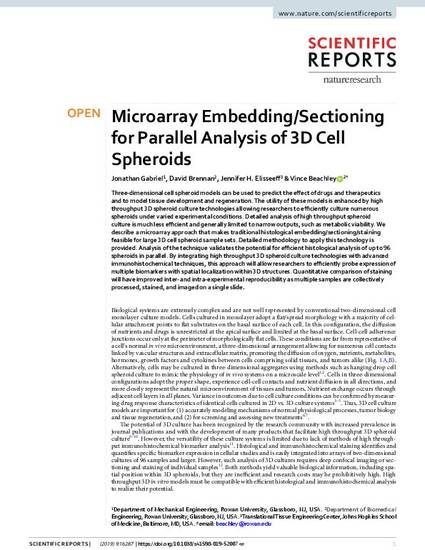
Article
Microarray Embedding/Sectioning for Parallel Analysis of 3D Cell Spheroids
Scientific Reports
(2019)
Abstract
Three-dimensional cell spheroid models can be used to predict the effect of drugs and therapeutics and to model tissue development and regeneration. The utility of these models is enhanced by high throughput 3D spheroid culture technologies allowing researchers to efficiently culture numerous spheroids under varied experimental conditions. Detailed analysis of high throughput spheroid culture is much less efficient and generally limited to narrow outputs, such as metabolic viability. We describe a microarray approach that makes traditional histological embedding/sectioning/staining feasible for large 3D cell spheroid sample sets. Detailed methodology to apply this technology is provided. Analysis of the technique validates the potential for efficient histological analysis of up to 96 spheroids in parallel. By integrating high throughput 3D spheroid culture technologies with advanced immunohistochemical techniques, this approach will allow researchers to efficiently probe expression of multiple biomarkers with spatial localization within 3D structures. Quantitative comparison of staining will have improved inter- and intra-experimental reproducibility as multiple samples are collectively processed, stained, and imaged on a single slide.
Publication Date
December, 2019
Publisher Statement
Scientific Reports is an Open Access journal published by Springer Nature.
Citation Information
Jonathan Gabriel, David Brennan, Jennifer Elisseeff and Vince Beachley. "Microarray Embedding/Sectioning for Parallel Analysis of 3D Cell Spheroids" Scientific Reports Vol. 9 (2019) p. 16287 Available at: http://works.bepress.com/vincent-beachley/33/
